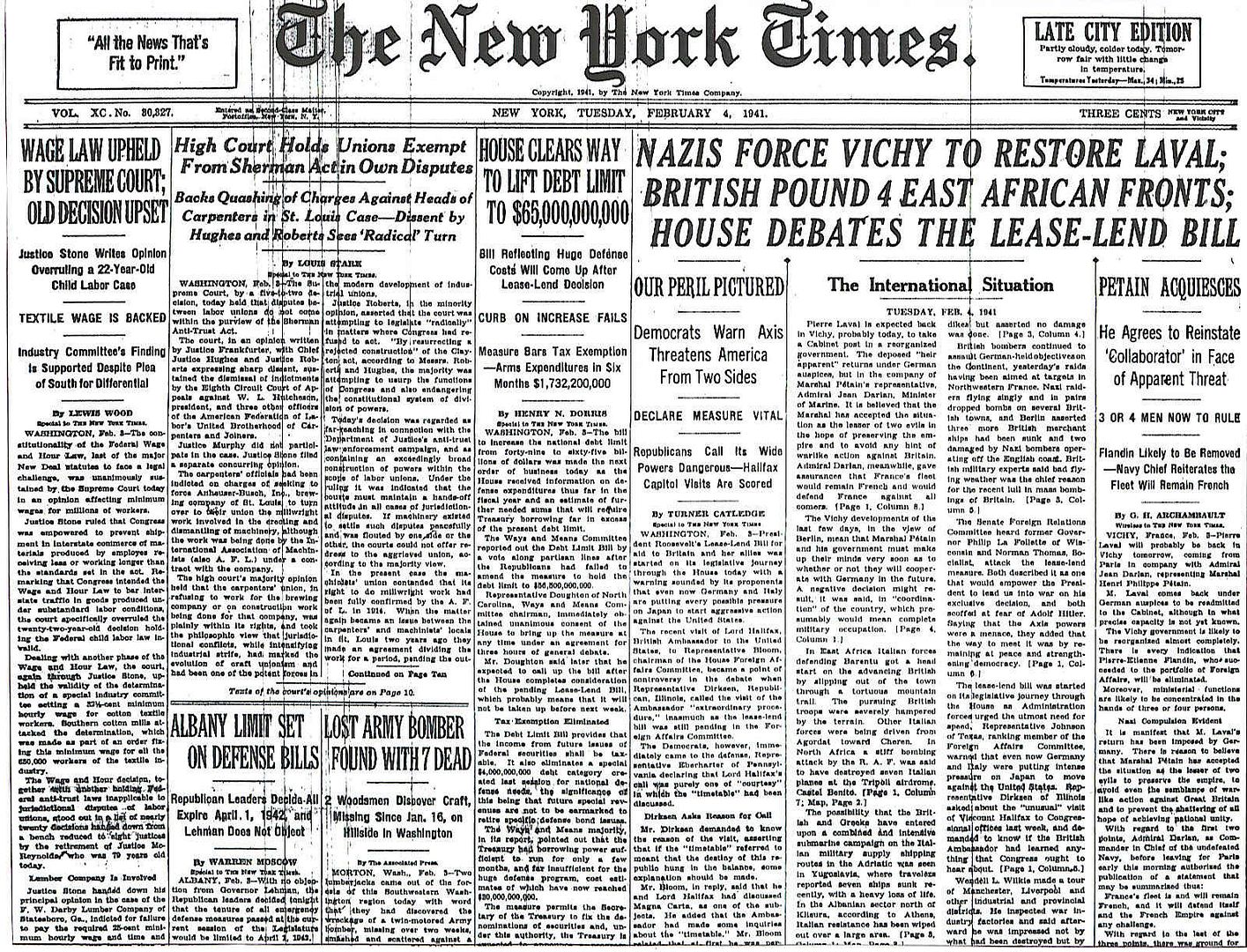
Posted on 02/04/2011 5:26:03 AM PST by Homer_J_Simpson

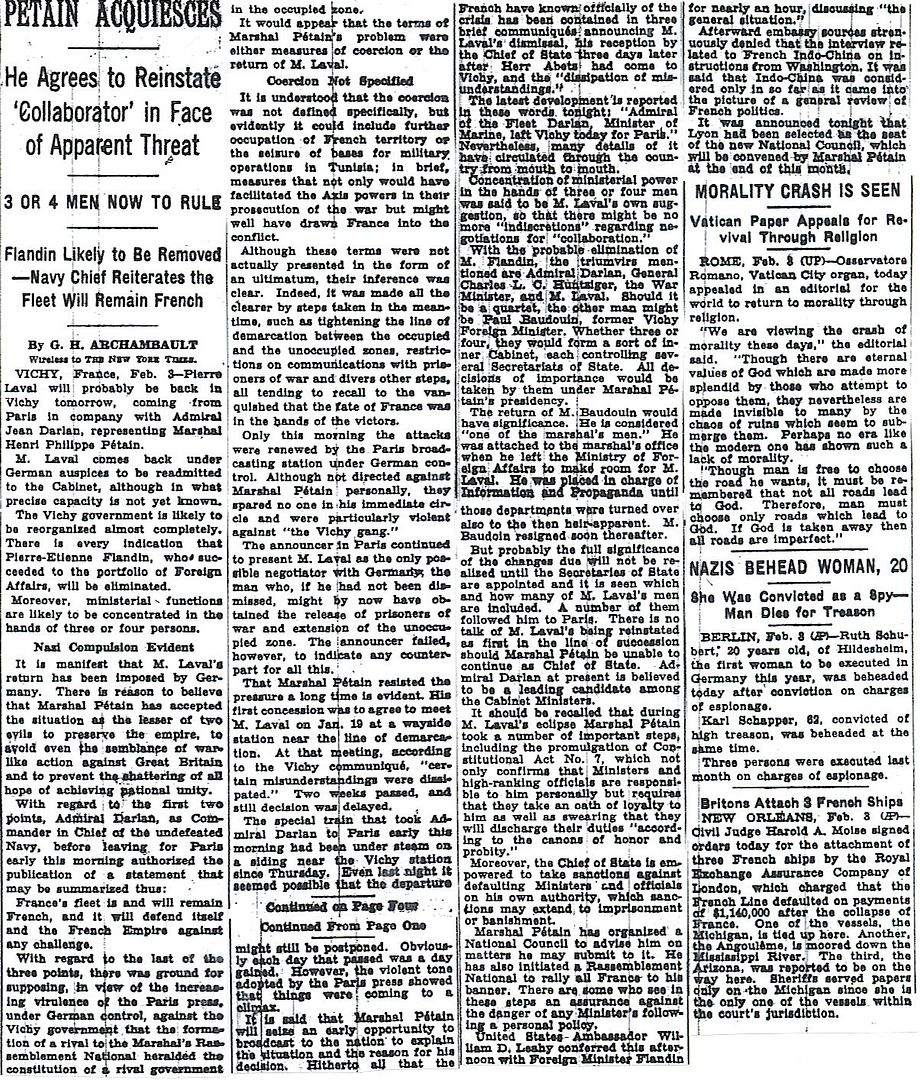
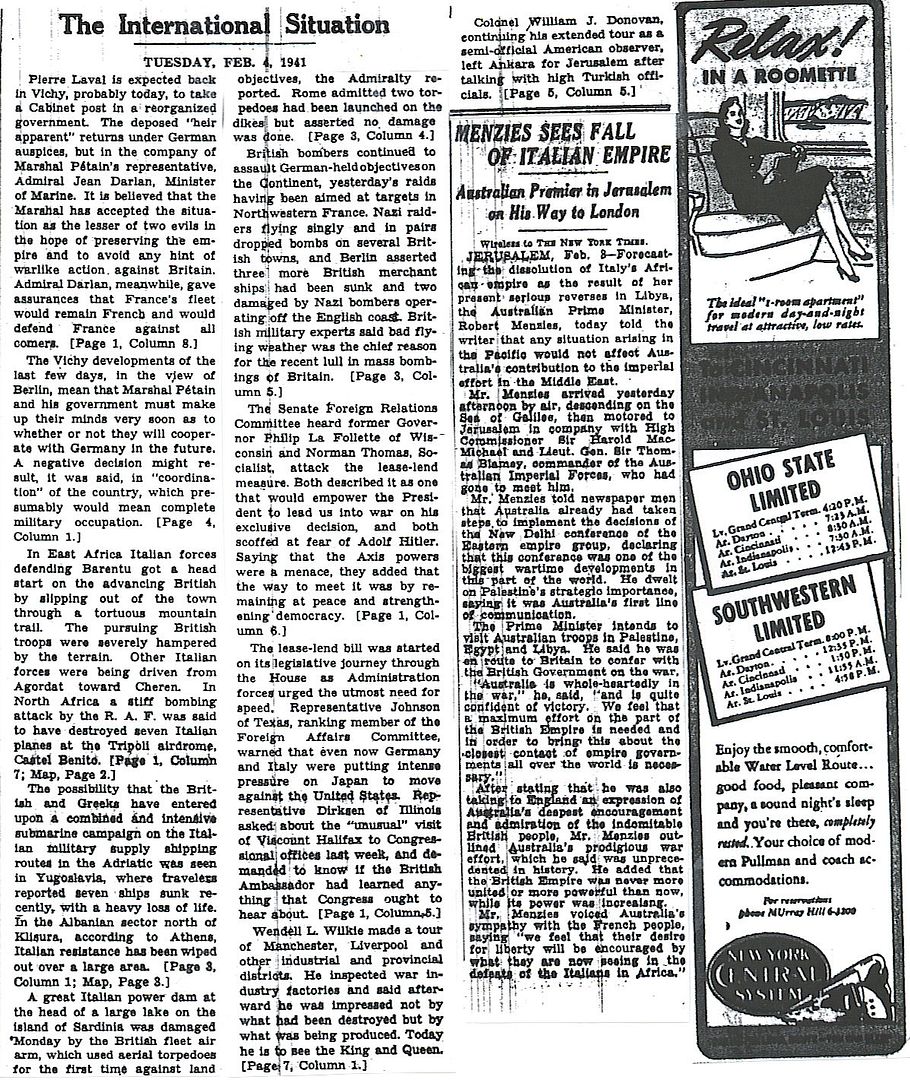

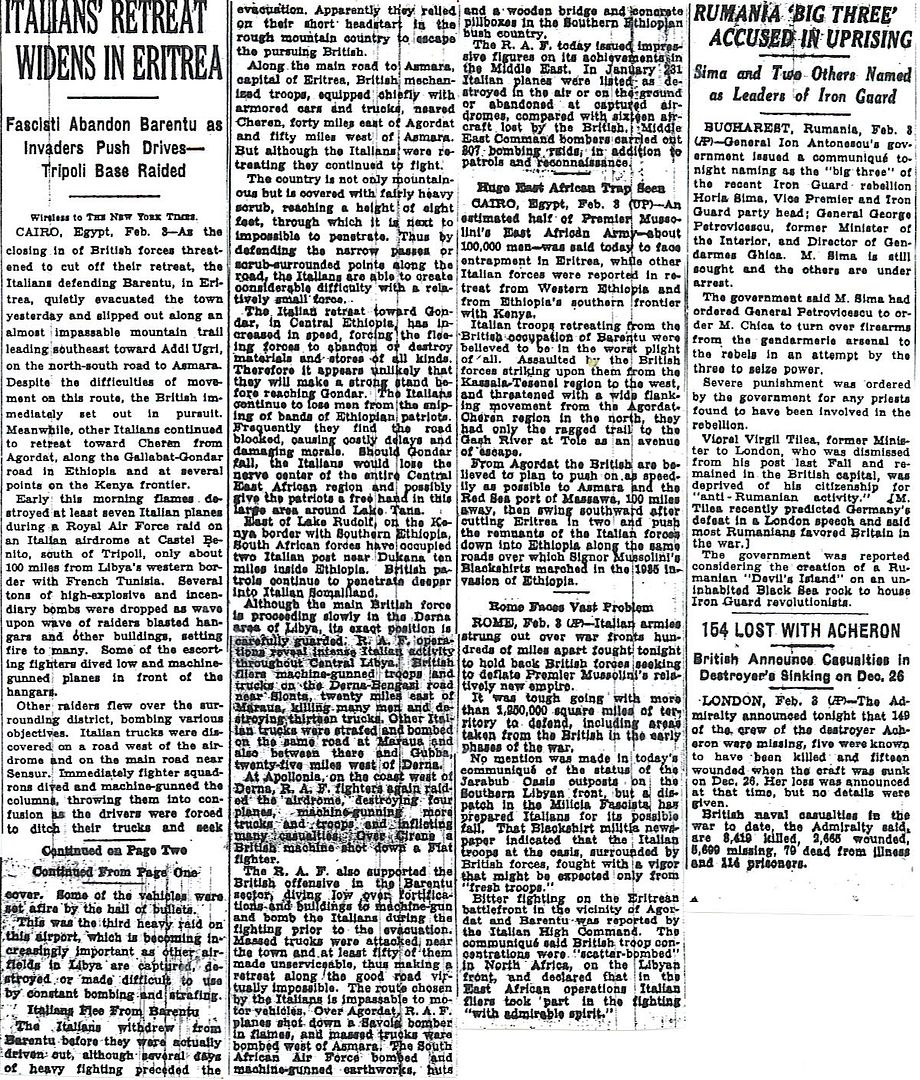
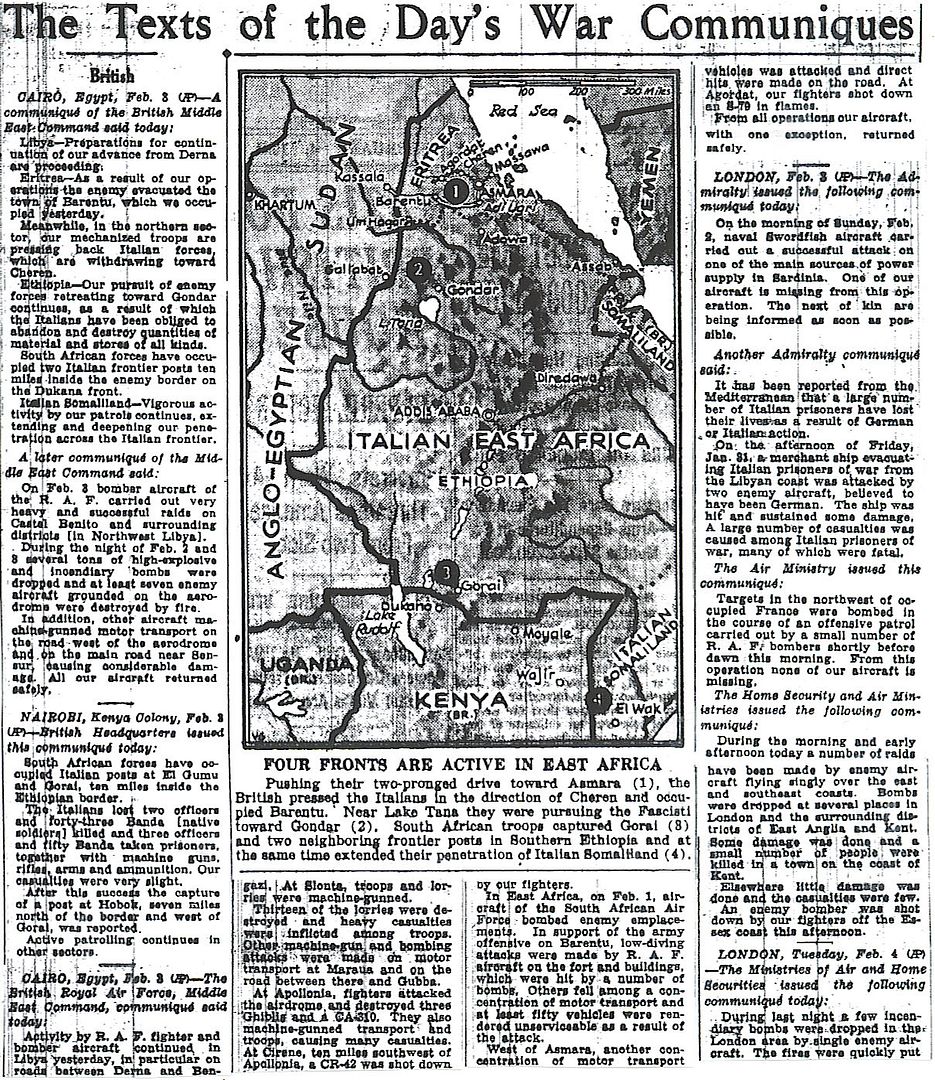

http://www.onwar.com/chrono/1941/feb41/f04feb41.htm
British advancing in desert
Tuesday, February 4, 1941 www.onwar.com
In North Africa... The British advance across Cyrenaica has now begun. Msus is taken and the forces then move toward Antelat. In the north the Italian retreat is continuing.
In East Africa... The British forces begin to attack the strong Italian positions around Keren. There are 30,000 Italian troops in this area. In the first phase of the battle, which last until February 7th, the 11th Indian Brigade manages to take Cameron Ridge but is thrown back from other positions by Italian counterattacks.
http://homepage.ntlworld.com/andrew.etherington/month/thismonth/04.htm
February 4th, 1941
UNITED KINGDOM: The cost of the war for Britain is now soaring rapidly. Last July it was about GBP 7.5 million a day. Now it is above GBP 11 million.
Sir Kingsley Wood, the Chancellor, gave this grim news today. Higher war output and other military preparations have far exceeded Treasury calculations. The current budget deficit is twice the size estimated eight months ago. MPs are now braced for drastic tax increases. Tax is meeting only one-quarter of all expenditure.
The 8,000 ton cargo ship SS POLITICIAN bound from Liverpool to Jamaica grounds off Eriskay in the Hebrides. The locals loot the ship of its cargo of 250,000 bottles of whisky, giving rise to Compton MacKenzie’s book, “Whisky Galore”. Later made into the classic Ealing comedy. (Marc James Small and Dave Shirlaw)
Corvette HMS Spikenard arrived South Shields, Tyne for completion.
Destroyer HMS Glaisdale laid down. (Dave Shirlaw)
GERMANY: AP reports that no air raids have been aimed at Berlin since December 21st. The RAF seems to be concentrating on Bremen and Wilhelmshaven. The Nazis have described these as “more serious than any other English raids.”
LIBYA: Led by 4th Armoured Brigade under Brigadier ‘Blood’ Caunter, with the 11th Hussars in the front, 7th Armoured Division strikes out across the Cyrenaica desert to cut the coast road to Benghazi, 150 miles away.
British armoured cars occupy Msus, and the forces then move toward Antelat.
Wavell telegrams to CIGS:
Information indicates that enemy is making hurried withdrawal westwards from Cyrene and possibly south from Benghazi.
What remains of 7 Armed Div. is advancing on Zt Msus and may reach there this evening. Tomorrow it will try to cut roads leading south from Benghazi. RAF is attacking retreating columns.
ERITREA: The British forces begin to attack the 30,000 Italian troops in strong positions around Keren. In the first phase of the battle, which lasts until 7 February, the 11th Indian Brigade manages to take Cameron Ridge but is thrown back from other positions by Italian counterattacks. (Jack McKillop)
TERRITORY OF HAWAII: The Search for the unidentified submarine off Oahu, begun yesterday, continues. After destroyers USS Dale (DD-353) and USS Hull (DD-350) return to Pearl Harbor, destroyers USS Flusser (DD-368) and USS Drayton (DD-366) join USS Lamson (DD-367) in the hunt. Ultimately, however, the search is called off. (Jack McKillop)
CANADA:
Corvette HMCS Alberni commissioned.
Corvette HMCS New Westminster laid down Victoria, British Columbia. (DS
U.S.A.: An editorial in the Chicago Tribune reports the leaked contents of a report from the Secretary of War which states that “...the American army today has not even one combat airplane with the gun power, the self-sealing fuel tank, and the armour protection for the pilot which the fighting in Europe has shown to be necessary.”
The Salvation Army, the YMCA and YWCA, the National Catholic Community Services, the National Travelers Aid Association and the National Jewish Welfare Board pooled their resources, at the request of U.S. President Franklin D. Roosevelt, to form a new organization. The United Service Organizations (USO) was created to provide unduplicated recreational services to members of the U.S. Armed Forces who were on pass or leave. (Jack McKillop)
The American United Press News Agency reports:
The US Army tank arm has begun to carry out an enormous expansion program based on plans which have been developed, continuously improved and modernised since 1928. The army has always realised the striking power of rapid-moving tanks but, armoured officers explain, considered it wiser to avoid spending billions of dollars for the production of tanks that would then have to be stored in giant depots until the day they were mobilised, and that might by then have become outdated. The army trusted in geographical position of the USA to give it time to assemble, whereas the European nations are compelled to keep their armies and arms always ready to deploy.
PUERTO RICO: Fleet Landing Exercise (FLEX) No. 7 begins in the Culebra-Vieques area, with all available ships of the Atlantic Fleet and elements of the 1st Marine Division and the U.S. Army’s 1st Division, to train “Army and Navy Forces in the amphibious operations incident to a Joint Overseas Expedition.” Unlike FLEX No. 6 in 1940, bona fide transports are available for, and participate in, the manoeuvres. (Jack McKillop)
ATLANTIC OCEAN:
At 1644, SS Empire Engineer, a straggler from Convoy SC-20, was torpedoed and sunk by U-123 SE of Cape Farewell. The master and 38 crewmembers were lost.
SS Ringhorn torpedoed and sunk by U-52 at 55.46N, 22.36W.
On 3 Feb 1941, SS Dione II, a straggler from Convoy SC-20, was bombed and damaged by a German FW 200 Condor aircraft of I/KG 40 in 55°40N/14°23W. On 4 February, the damaged Dione II was shelled and sunk by U-93 NW of Aran Island, Co. Galway. The master, 26 crewmembers and one gunner were lost. Five crewmembers were picked up by the British SS Flowergate and landed at Glasgow. (Dave Shirlaw)
http://worldwar2daybyday.blogspot.com/
Day 523 February 4, 1941
Operation Compass. Italians begin evacuating Benghazi, Libya. At dawn, 7th Armoured Division leaves Mechili to cross 150 miles of desert South of the lush, hilly Jebel El Akhdar (“Green Mountains”) and cut off the Italian retreat. The tanks make slow progress so General Creagh sends ahead a mobile group of infantry in armoured cars towing artillery under Colonel John Combe (Combe Force).
At 4.40 AM, U-93 finishes off British SS Dione II with the deck gun and antiaircraft gun (27 crew and 1 gunner killed, 5 crew rescued by British steamer Flowergate). At 8.38 AM 500 miles West of Ireland, U-52 sinks Norwegian SS Ringhorn carrying 1300 tons of coal from Britain to USA (14 crew die but corvette HMS Camellia picks up 5 survivors on rafts after 6 hours in heavy seas). At 4.44 PM, U-123 sinks British SS Empire Engineer carrying 7047 tons of steel from USA to Britain, in the middle of the Atlantic 1000 miles West of Ireland (all 39 hands lost, although the crew is seen to abandon ship on rafts).
RAF bombs Düsseldorf.
German pocket battleships Scharnhorst and Gneisenau break out undetected into the Atlantic Ocean via the Denmark Strait.
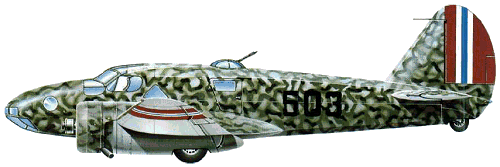
RAF destroyed three CA 310 .....
How in the heck do you cull the news from that period to post only relevant pages?
Just an amazing insight on the views and happenings of the time.
Someone should give you a medal or something. Can’t be easy doing what you do.
That plane reminds me of the Lockheed Hudson. A little smaller and a lot lighter (fabric skin and some structural wood, rather than all metal), but apparently able to carry a little more weight in bombs over about half the distance.
I think Italian aircraft from the 20,30 and 40’s are beautiful birds.
Today’s post shows the injustice of what was done to Petain after the war. He was doing the best he could to preserve France while holding a very bad hand.
They were competitive with the Russians, but didn't measure up to the British, German, or American planes.
I try to let the folks from 70 years ago tell me what was relevant to them. I get the lead story every day (page 1, right-hand column). Then I pick two or three other front page articles and follow them all to the back pages where they finish. Sometimes I find that by printing the conclusion of a story I picked I get the conclusion of a front page story I didn't pick. If I have the beginning of that one I will post it, too.
The way I have worked it out I can get a complete newspaper page in four copies. I generally get a few back-page stories and fillers with each complete front page article.
Once I have the front page covered I finish scrolling through the day's edition. That is where I get the happy accident stories. Like something that they attributed little importance to back then but that we now know developed into something major. The daily war communiques are almost always on page 2. Hanson Baldwin's column could be anywhere in the news section. If I am in a spell of well-preserved copy I keep an eye out for nice photos as I zoom along.
Time is generally my major constraint. I am limited to roughly 15 minutes for a Mon.-Sat. edition and a half hour for Sunday. I can go for about six hours before I run out of time or focus.
The nagging question I take with me each time is, what did I miss?
Just plain interesting.
Thanks again.
Exactly ....amazing read...astounding really in light of world affairs now. Simpson, you need to be on the CIA payroll!
Ping.....very interesting newspaper read from 1941.....reads like news today! Very insightful.
Disclaimer: Opinions posted on Free Republic are those of the individual posters and do not necessarily represent the opinion of Free Republic or its management. All materials posted herein are protected by copyright law and the exemption for fair use of copyrighted works.